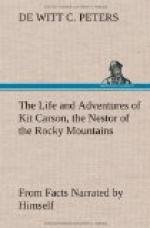“The whole idea of such a desert and such a people, is a novelty in our country, and excites Asiatic, not American ideas. Interior basins, with their own systems of lakes and rivers, and often sterile, are common enough in Asia; people in the elementary state of families, living in deserts, with no other occupation than the mere animal search for food, may still be seen in that ancient quarter of the globe; but in America such things are new and strange, unknown and unsuspected, and discredited when related. But I flatter myself that what is discovered, though not enough to satisfy curiosity, is sufficient to excite it, and that subsequent explorations will complete what has been commenced.”
“This account of the Great Basin, it will be remembered, belongs to the Alta California, and has no application to Oregon, whose capabilities may justify a separate remark. Referring to my journal for particular descriptions, and for sectional boundaries between good and bad districts, I can only say, in general and comparative terms, that, in that branch of agriculture which implies the cultivation of grains and staple crops, it would be inferior to the Atlantic States, though many parts are superior for wheat, while in the rearing of flocks and herds it would claim a high place. Its grazing capabilities are great; and even in the indigenous grass now there, an element of individual and national wealth may be found. In fact the valuable grasses begin within one hundred and fifty miles of the Missouri frontier and extend to the Pacific Ocean. East of the Rocky Mountains, it is the short, curly grass, on which the buffalo delight to feed (whence its name of buffalo), and which is still good when dry and apparently dead. West of those mountains it is a larger growth, in clusters, and hence called bunch grass, and which has a second or fall growth. Plains and mountains both exhibit them; and I have seen good pasturage at an elevation of ten thousand feet. In this spontaneous product, the trading or traveling caravans can find subsistence for their animals; and in military operations any number of cavalry may be moved, and any number of cattle may be driven, and thus men and horses be supported on long expeditions, and even in winter in the sheltered situations.




